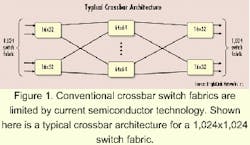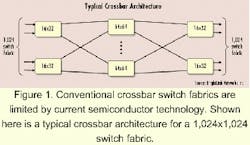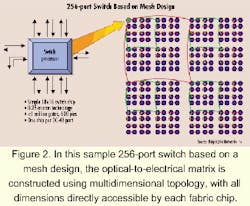Optical-electrical-optical switching offers solution, challenges to system designers
Alan Stewart, Network Interface Corp., and Gary Law, BrightLink Networks Inc.
As service providers rapidly transition from circuit-switched, voice-only networks to Internet-protocol (IP)/ Multiprotocol Lab el Switching systems, practical and cost-effective solutions for future optical-networking equipment are needed. Until the limitations of all-optical (OO) switching can be overcome, the use of optical-to-electrical-to-optical (OEO) switching is still the most economical and quickly deployable solution for these next-generation networks.
Due to the legacy nature of public telecommunications, existing telephone network equipment was built to last for about 15 years, and systems were designed to serve tens of millions of subscribers with simple, reliable, inexpensive voice communications. To expect a network of this nature to handle the exponential growth in traffic caused by the Internet is unrealistic. It was not intended to do so. Today, this infrastructure based on decade-old equipment strains to cope with escalating amounts of data in fast packet form.
That is not the end of the traditional network's troubles. The advent of dense wavelength-division multiplexing (DWDM) increases the bandwidth available for new services by several orders of magnitude, further straining the ability of existing Synchronous Optical Network (SONET) bandwidth management and provisioning devices. In other words, a solution in one area leads to problems in another; it simply pushes the problem from one part of the network to another. Installers of central-office (CO)-located equipment such as broadband digital crossconnects and SONET add/drop multiplexers (ADMs) face a next-to-impossible task when confronted with multiple wavelengths. Each ADM can handle only one lambda at a time, so the number of these devices escalates rapidly.
The impact on a backbone CO that must accommodate an incoming fiber pair equipped with 16-lambda OC-192 (10-Gbit/sec) DWDM is dramatic. Carriers now would need to install 16 OC-192 ADMs with OC-48 (2.5-Gbit/sec) tributaries, and 64 OC-48 ADMs with OC-12 (622-Mbit/sec) tributaries, to a 3x3 crossconnect system. A hub of this type, which typically provides a point of presence (PoP) for a major carrier, would serve routes in three geographical directions, each with four or more fiber pairs lit. The network elements would thus be multiplied by a least 12 (3 routes x 4 pairs) to support cross-sectional bandwidth through the node.
Another major issue facing today's service providers is circuit-provisioning time. A large carrier might have 35 to 50 PoPs in its network. To provision one OC-48 across the United States, manual connections between each DWDM terminal and SONET ADM would have to be made at each of these large COs. Each of these also would need to be wired through fiber patch panels to another, lower-bit-rate ADM and its associated equipment. Because the OC-48 might traverse 10 separate rings, the carrier would be faced with the task of manually identifying and reserving working and protection capacity for each customer. Given this scenario, provisioning times in excess of six months would not be uncommon.
Obviously, the solution to this problem is to find a better way of switching and managing multiple wavelengths.
On the system level, Paul John son, an analyst with Banc Boston Robertson Stephens, says that to reach a long-term solution, the industry must transition away from physical bidirectional line-switched rings to multilevel hierarchies and meshed light-path connections.1 He notes that the flow of aggregated IP traffic in a backbone exhibits a highly meshed pattern: "A data-optimized transport layer must also provide any-to-any capability. This allows the abstraction of capacity from the physical layer to where the bandwidth is needed at any one moment without changing any of the cabling connections of any equipment or the amount of virtual fiber provisioned on any one route."
The functionality and capacity de m ands of these optical networks of the future require that certain key equipment design considerations must be made in order to accommodate them. That's where the decision of what kind of switch fabric architecture to deploy is critical.
Next-generation switch-fabric architectures must allow for better use of space and power at much lower cost than legacy equipment. The technology must also provide an architecture tailored toward the provisioning time and traffic management needs of tomorrow's IP data networks.One way to achieve these objectives is to develop large OO switch fabrics. Most major telecommunications network equipment providers are actively developing "pure" OO switches. These vendors are working on all-optical switch technology because they believe that cost will be reduced over time by ultimately reducing or eliminating the number of OEO conversions required by today's fiber-optic communications technology. The ability to identify and switch separate wavelengths could at the same time eliminate current carrier dependence on repetitive use of optical crossconnects and ADM products-and make the provisioning of broadband circuits a relatively short and easy process.
However, today's OO switch fabrics still depend on optomechanical pro cesses to operate. These processes are hard to control and place limits on the number of optical cross-points actually achievable.
There are several other problems standing in the path of OO switches. One of these problems is that the minimum granularity in an all-optical switch network is a full wavelength (lambda), so even a small amount of additional bandwidth demand would require this commitment. Next, a lack of wavelength conversion requires single lambda end-to-end provisioning, significantly complicating systems management, provisioning, and optimization. And existing technology does not permit the development of all-optical systems cap able of switching to the level of reliability required to dynamically groom and provision the network.
To overcome the limitations of pure OO switching, an architecture is needed that can accommodate multiple wavelengths without the need for external multiplexers. Yet, at the same time, it must be able to switch individual lambdas electronically, thus obtaining the granularity necessary to switch both through traffic (express) and local traffic.
An OEO approach offers one solution to this problem. With an OEO device, multiple wavelengths arrive at the switch, are converted into single wavelengths, changed into an electrical carrier, and switched by a matrix of powerful processors, each one representing one port of the switch. After this process, the switched signals are converted back into optical carrier and sent into the network.
However, scalability has been a limiting factor in conventional OEO switches because they are hardware intensive and become unwieldy when large numbers of wavelengths need to be switched. A hybrid OEO technology used in a new, mesh switch-fabric architecture resolves the scalability issue.
An architecture based on OEO technology could incorporate add/drop multiplexing capability at its input and output nodes, allowing individual wavelengths to be switched within an electrical matrix consisting of specialized microprocessors. It would then be able to convert the signal back into an optical carrier for distribution both locally and throughout the network. The incorporation of sophisticated software could enable the carrier to use computer-generated commands to switch traffic over a mesh network to other similar switches.
Switching systems based on electronic crossbar switch fabrics have been the standard architecture for data-communications and telecommunications switches for well over a decade (see Figure 1). This architectural approach is well understood and has been able to keep pace with the bandwidth needs for both data-communications and tele com munications using semiconductor-technology improvements progressing at Moore's Law rates.
Today, the vast majority of switches, including those based on OEO, use this architecture. However, the explosion of the Internet has changed everything. Bandwidth growth rates have skyrocketed and the growth rate is such that traditional switch architectures dependent on Moore's Law rates of improvement simply cannot keep up. Therefore, many designs have assumed that OEO-based architectures in general cannot keep up, and the only choice is to move to pure optical switching that, in theory, has limitless bandwidth capabilities.
The design team at BrightLink Net works has taken a different approach in developing its new scalable, multiterabit optical transport switch. Instead of abandoning the OEO approach, the team looked for an innovative way to construct a switch fabric that could scale with the bandwidth demand of the Internet within the constraints of semiconductor im provement rates.
The new switch emulates a circuit switch; thus, there is no routing. It can send units of information consisting of STS-1s, and each port emulates a single-wavelength ADM. Managing the switch as a mesh network with multiple COs allows customers to provision from one STS-1 to a full OC-192 with a workstation. Software is the product's key component because the box has been designed with knowledge and awareness of a network of similar devices.BrightLink's solution has its roots in the evolution of the supercomputer. It became very evident in the evolution of supercomputers that building bigger and bigger single-processor systems could not continue to scale at an acceptable rate. The solution to this problem was to move to an architecture of smaller multiple processors working in parallel. Instead of relying on ever-larger crossbar chips to build switches with a large number of ports, the design team chose to develop an architecture based on small switch processors interconnected in a hypertorus mesh structure (see Figure 2).
The economics of large processors make it difficult to scale traditional, single-processor circuit switches to meet modern traffic conditions. Each processor supports one port, so the switch can be scaled by adding chips that increase capacity. Very large switches can be constructed simply by adding more of these small switch processors. Traffic flow can be managed using complex software algorithms, and the architecture expands to meet additional demand for bandwidth.
The switch's optical-to-electrical matrix is constructed using multidimensional topology, with all dimensions directly accessible by each fabric chip. The result is better performance, lower switch-fabric chipset cost, and a 10- to 100-times increase in maximum size over conventional crossbar construction. Using this architecture under actual working conditions, the switch was able to achieve scalable, intelligent optical-switching capabilities of up to 1,024 OC-48 ports per switching element and 64 OC-48 ports per 21.5x31.5x18-inch-depth shelf.
The ever-growing need for bandwidth and speed is being fueled by billions of dollars of electronic commerce conducted daily over an IP-based backbone. To handle this imminent deluge of data requires changes in the way optical connections are provisioned.
Consultant Alan Stewart is president of Network Interface Corp. (Crystal Lake, IL). Gary Law is vice president of marketing for BrightLink Networks Inc., an optical-network system vendor in Sunnyvale, CA.
- "Guide to Building a Next Gen eration Network in 1999," by Paul Johnson, CFA, published by Banc Boston Robertson Stephens, May 3, 1999.
This article appeared in the May 2000 issue of Integrated Communications Design, Lightwave's sister publication.


